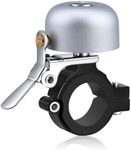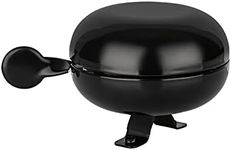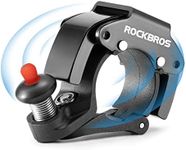Buying Guide for the Best Bicycle Bells
Choosing the right bicycle bell is essential for ensuring safety and communication while riding. A good bell should be loud enough to alert pedestrians and other cyclists of your presence, yet pleasant enough not to startle them. When selecting a bicycle bell, consider the type of riding you do, the environment in which you ride, and your personal preferences for style and sound. Understanding the key specifications of bicycle bells will help you make an informed decision that enhances your cycling experience.Sound VolumeSound volume is the loudness of the bell when it is rung. This is important because it determines how well others can hear you, especially in noisy environments or busy streets. Bells can range from soft, gentle chimes to loud, piercing rings. If you ride in urban areas with heavy traffic, a louder bell might be necessary to ensure you're heard. For quieter, suburban or rural areas, a softer bell may suffice. Consider where you ride most often and choose a bell with a volume that matches those conditions.
Sound TypeSound type refers to the tone and pitch of the bell. Different bells produce different sounds, from a classic 'ding-dong' to a single 'ding' or even a melodic chime. The sound type is important because it affects how recognizable and pleasant the bell is to others. If you prefer a traditional sound, a classic bell might be best. For a unique or less intrusive sound, consider a bell with a different tone. Think about the environments you ride in and choose a sound that will be effective and appropriate.
Mounting StyleMounting style refers to how the bell attaches to your bicycle. This is important for ensuring the bell is secure and easy to use while riding. Common mounting styles include handlebar clamps and straps. Some bells are designed for specific handlebar diameters, so it's crucial to check compatibility with your bike. If you frequently switch bikes, a universal or adjustable mount might be more convenient. Consider how often you might need to remove or adjust the bell and choose a mounting style that suits your needs.
MaterialThe material of a bicycle bell affects its durability, weight, and sound quality. Bells are commonly made from metal, plastic, or a combination of both. Metal bells, such as those made from brass or aluminum, tend to produce a clearer, louder sound and are more durable. Plastic bells are often lighter and may come in a wider variety of colors and designs. If you prioritize sound quality and longevity, a metal bell might be the best choice. For a lightweight or colorful option, consider a plastic bell.
Design and AestheticsDesign and aesthetics refer to the visual appearance of the bell. This is important for personalizing your bike and ensuring the bell complements your style. Bells come in a wide range of designs, from sleek and minimalist to colorful and whimsical. If you want your bell to blend in with your bike, choose a design that matches its color and style. For a fun or standout look, opt for a bell with a unique design or pattern. Consider your personal taste and how the bell will look on your bike.









![[New 2025] BX500-BEL 3 in 1 Bike Li](https://images-proxy.bestreviews.guide/1M17Juwtei-2ENvqVY2vaFM_F4k=/0x150/https://m.media-amazon.com/images/I/51Ro5egGIdL._AC_CX679_.jpg)




